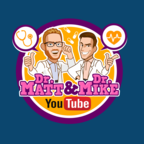
Dr Matt & Dr Mike's Medical YouTube
Summary: Dr. Mike Todorovic & Dr. Matt Barton are Medical Educators from Australia that love teaching about the Human Body. We also have a podcast!! Dr. Matt & Dr. Mike's Medical Podcast Facebook: Dr Matt & Dr Mike's Medical Podcast Twitter: @drbartox @mickeytod @gubiosciences These brief concept captures are designed to supplement student learning for the following subjects: - Anatomy - Physiology - Pathophysiology - Pharmacology
- Visit Website
- RSS
- Artist: Dr. Mike Todorovic
Podcasts:
In this video, Dr Mike explains the process of rigor mortis, also known as postmortem rigidity. Characterised by the stiffening of the limbs of an individual after they die. This ties into the process of muscle contraction!
In this video, Dr Mike outlines why it is important to understand the embryological origin of abdominal organs when it comes to understanding abdominal pain. He talks about pain associated with hollow structures like the bowel, pain associated with solid structures like the liver, and pain that has spread to the wrapping of the abdominal organs called the peritoneum.
What is the chemical structure of DNA? What are nucleotides? How are they important biological building blocks of the body?
In this video, Dr Mike explains the chemical composition of carbohydrates and the common monosachharides, disaccharides, and polysaccharides.
What are atoms? How are they different to elements? Why and how does our body convert atoms into charged ions?!
In this video, Dr Mike explains the process of glycolysis and how we can make pyruvate from glucose. He also explains some important regulators of glcolytic enzymes.
In this video, Dr Mike explains how glucose is transported from the intestines to the blood, from the blood to the tissues, and from the kidneys back into the blood! All of this glucose transport requires channels called SGLT and GLUT. Dr Mike will tell you where each GLUT transporter can be found!
Dr Matt explains medical acid-base problems. Video explain acidosis, acidaemia, alkalosis, alkalaemia, ABGs, pH, and more.
In this video, Dr Mike explore gas exchange under high pressure and explains nitrogen sickness and 'the bends'.
A 24-year-old female, who is vegan, presents to her GP with extreme fatigue and shortness of breath on minimal exertion. A FBC diagnoses her with normocytic anaemia. Based on this diagnosis, what type of anaemia does she have? a) Iron-deficiency anaemia b) Haemolytic anaemia c) Pernicious anaemia d) Thalassiamia e) A & C
A 49-year-old male presents to his GP complaining of chest pain. An ECG reveals an ST elevation. Which of the following medications correctly matches its mechanism of use for a suspected STEMI. A) Aspirin, anti-inflammatory; reduces swelling in the coronary arteries, thus supplying more blood to the heart. B) Glyceryl trinitrate, produces nitric oxide; to vasodilate the coronary arteries and supply more oxygen to the heart. C) Atenolol, stimulates B1 receptors in the kidney to release renin; which increases pre-load and afterload pressures and thus increasing blood pressure D) Morphine, opioid analgesic; reduce sympathetic activity, thus reducing myocardial oxygen demand E) Heparin, anti-coagulant; to reduce further platelets aggregating around plaque. F) Atorvastatin, lipid regulating drug; prevents further atherosclerosis in the affected coronary vessel.
In this video, Dr Mike discusses neural control of the heart. This includes the role of the sympathetic (fight or flight) and parasympathetic (rest and digest) nervous system.
A 65-year-old male is diagnosed with COPD and develops elevated pulmonary vascular resistance. Which of the following heart failures along with its correct mechanism is likely to occur. a) Left sided heart failure due to an increased afterload b) Right sided heart failure due to a decreased preload c) Right sided heart failure due to a loss in contractility d) Left sided heart failure due to increased preload e) Right sided heart failure due to increased afterload f) Bi-ventricular failure due to decreased preload on right and increased preload on left.
In this video, Dr Mike discusses how pacemaker cells, like the SA node and AV node create different action potentials compared to cardiomyocytes (heart muscle cells).
In this video, Dr Mike summarises the current evidence regarding the use of CBD for various health conditions.